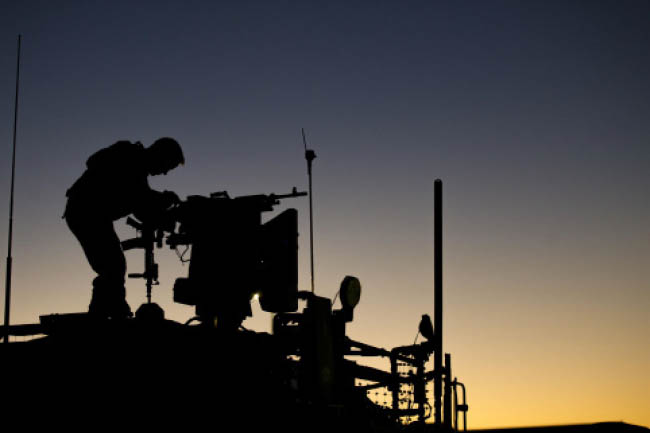WASHINGTON - One day after meeting at the Camp David presidential retreat with his national security team to consider strategic options, Trump tweeted, “Important day spent at Camp David with our very talented generals and military leaders. Many decisions made, including on Afghanistan,” he wrote, without providing details.
White House Press Secretary Sarah Huckabee Sanders said Friday that a new strategy would “protect America’s interests” in the South Asian region and that details would be forthcoming.
“The president is studying and considering his options and will make an announcement to the American people, to our allies and partners, and to the world at the appropriate time." She did not specifically mention Afghanistan.
Friday’s meeting was the most recent in a series of high-level talks on a broader security strategy for Afghanistan and the greater South Asia region. Finalizing a strategy has been delayed by internal differences.
Among the attendees were Vice President Mike Pence and Defense Secretary James Mattis.
Without offering hints, Mattis told reporters Thursday in Washington he anticipated a decision on the new approach to the war, the longest in U.S. history, would be made “in the near future.
Before a new strategy is adopted, the administration has said it would review its approach to the broader South Asia region, including Pakistan and India. Options include sending thousands of additional troops to the war-torn country or withdrawing them altogether, leaving private military contractors to help manage the country's tenuous security situation.
After years of extensive support from the U.S. and other NATO member nations, the Afghan military is still struggling to resist the Taliban, which recently made advances in Afghanistan and the Pakistan border region. U.S. generals have described the conflict as a "stalemate."
The U.S. Defense Department approved a plan months ago to send about 3,800 additional troops to assist the Afghan army, but some White House officials questioned whether more resources would be effective.
Trump authorized Mattis to determine troop numbers in Afghanistan, but several months later, allied troop levels remain unchanged. About 8,400 U.S. troops and an estimated 5,000 NATO troops are in the country, serving primarily in advisory and training capacities. The U.S. also maintains a force in Afghanistan that is tasked with fighting terrorist groups, including Islamic State and al-Qaida.
Mattis has said he would commit to troop level adjustments after the administration agrees on a coherent strategy for Afghanistan and the broader region, including Pakistan's dealings with terrorist groups.
Rand Corporation South Asian expert Jonah Blank said intelligence reports he has received suggests an increase in troops is the currently the administration's most favored option.
"It sounds like the administration is leaning towards a modest increase in troop levels, perhaps between 3,000 and 5,000 troops ...without a termination date for their stay," Blank said.
Blank predicted a modest troop increase would not "change the overall trajectory of the war" given the failure of a collective effort to end the long-running conflict.
The founder of the Blackwater security firm, Erik Prince, and DynCorp owner Stephen Feinberg last month offered proposals to the White House to use contractors instead of U.S. troops.
But increasing numbers of influential Afghans are concerned private firms would not be accountable. They are concerned using contractors risks a reoccurrence of the heinous acts Blackwater Security Company guards committed in Afghanistan and Iraq about a decade ago.
The ability to reverse course in Afghanistan has been hindered by the government's struggles to stop Taliban advances without assistance. The Taliban now controls almost half the country, according to the latest report from the U.S. Special Inspector General for Afghanistan Reconstruction.
Afghan forces are also fighting an IS affiliate that has gained a foothold primarily in eastern Afghanistan, presenting an additional challenge without prospects of a near-term solution. This week, a U.S. soldier was killed and nearly a dozen others injured in a clash with the IS affiliate.
Members of Congress have expressed frustration over the long-running war and the lengthy administration search for a new strategy to break the stalemate.
Republican Senator John McCain declared last week that "America is adrift in Afghanistan."
"Nearly seven months into President Trump's administration, we've had no strategy at all as conditions on the ground have steadily worsened," added McCain, who is chairman of the Senate Armed Services Committee.
McCain has proposed an expansion of the U.S. counterterrorism operation and additional support for the Afghan military.
More than 15 years ago, the U.S. invaded Afghanistan and ousted the Islamist Taliban regime for giving al-Qaida a refuge to plot the September 11, 2001 terrorist attacks against the U.S.
There is no sign to the end of the war. U.S. intelligence agencies determined in May that conditions in Afghanistan would almost certainly worsen through next year, even if the U.S. and its allies provided a modest increase in military assistance. (VoA)
Home » Afghanistan » Decisions Made on War in Afghanistan: Trump
Decisions Made on War in Afghanistan: Trump

